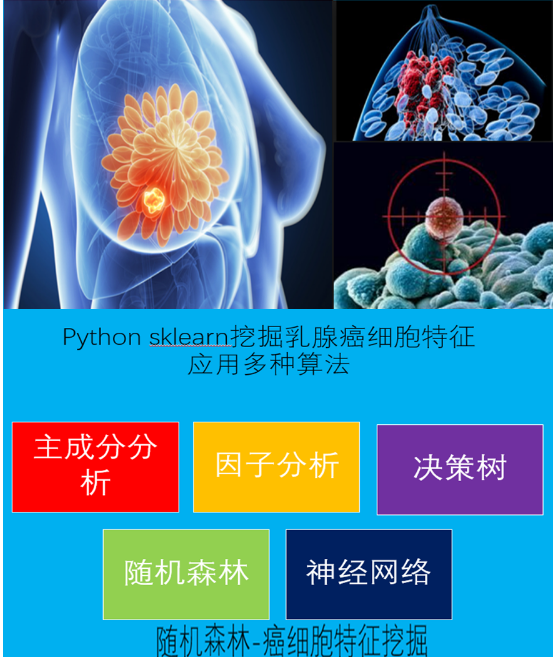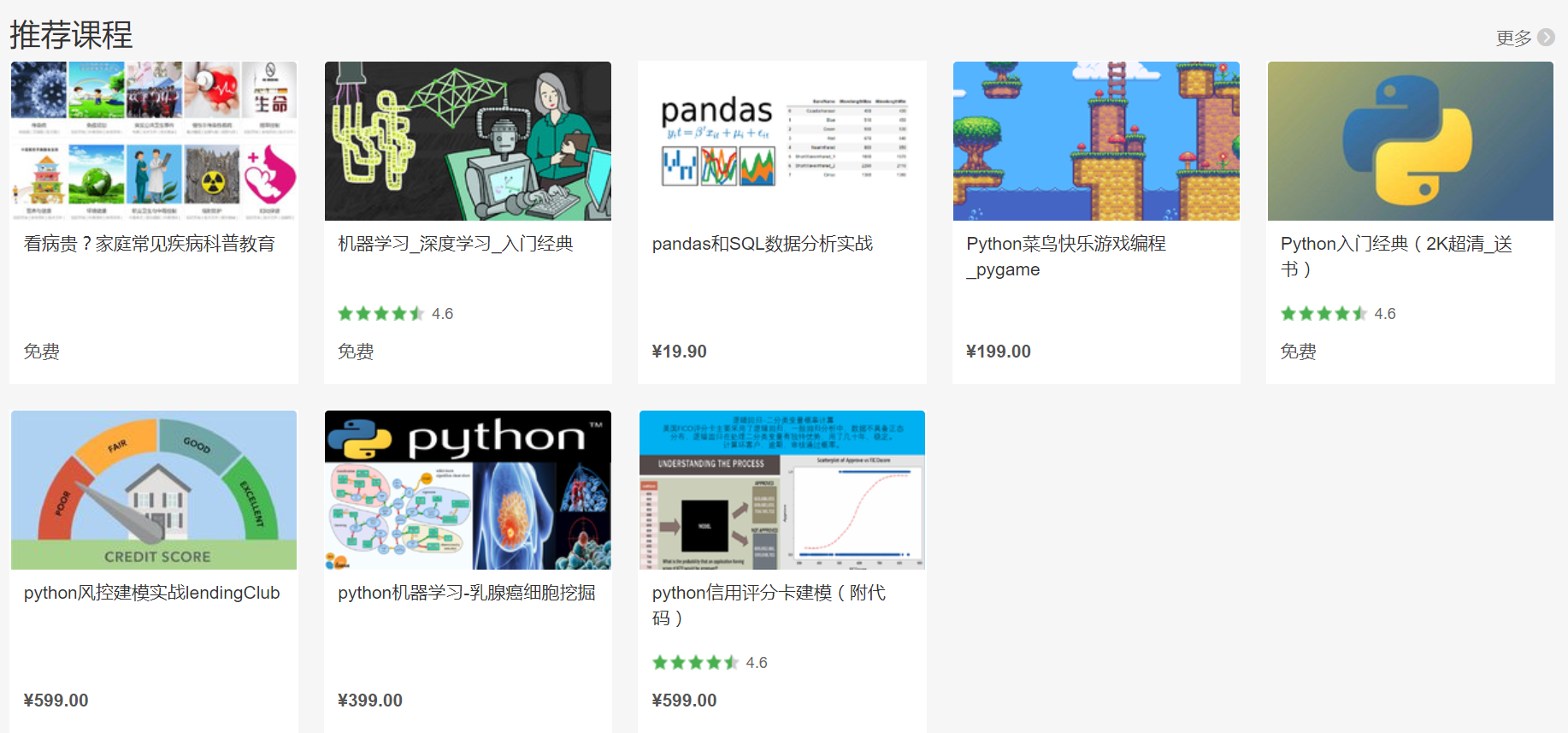自然语言16_Chunking with NLTK
python机器学习-乳腺癌细胞挖掘(博主亲自录制视频)https://study.163.com/course/introduction.htm?courseId=1005269003&utm_campaign=commission&utm_source=cp-400000000398149&utm_medium=share
Chunking with NLTK
对chunk分类数据结构可以图形化输出,用于分析英语句子主干结构
# -*- coding: utf-8 -*-
"""
Created on Sun Nov 13 09:14:13 2016 @author: daxiong
"""
import nltk
sentence="GW.Bush is a big pig."
#切分单词
words=nltk.word_tokenize(sentence)
#词性标记
tagged=nltk.pos_tag(words)
#正则表达式,定义包含所有名词的re
NPGram=r"""NP:{<NNP>|<NN>|<NNS>|<NNPS>}"""
chunkParser=nltk.RegexpParser(NPGram)
chunked=chunkParser.parse(tagged)
#树状图展示
chunked.draw()
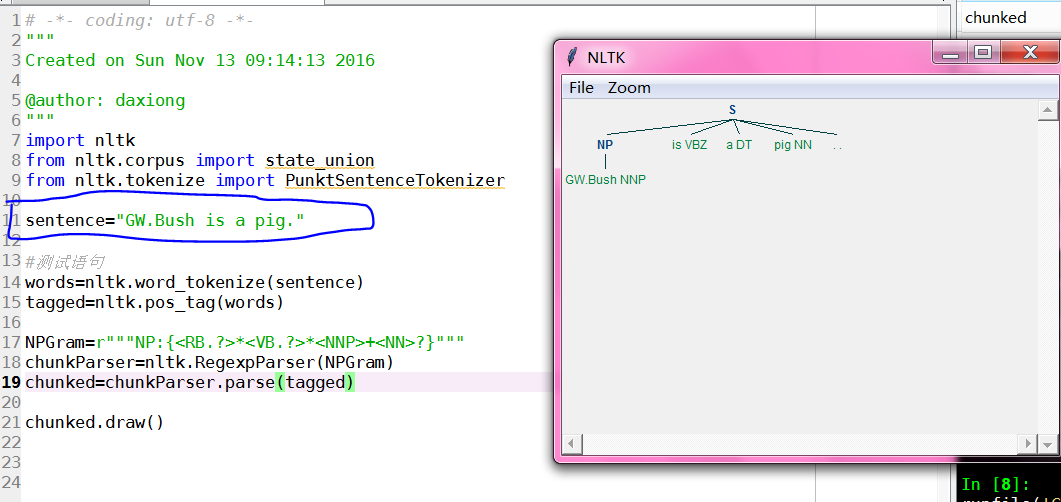
# -*- coding: utf-8 -*-
"""
Created on Sun Nov 13 09:14:13 2016 @author: daxiong
"""
import nltk
from nltk.corpus import state_union
from nltk.tokenize import PunktSentenceTokenizer #训练数据
train_text=state_union.raw("2005-GWBush.txt")
#测试数据
sample_text=state_union.raw("2006-GWBush.txt")
'''
Punkt is designed to learn parameters (a list of abbreviations, etc.)
unsupervised from a corpus similar to the target domain.
The pre-packaged models may therefore be unsuitable:
use PunktSentenceTokenizer(text) to learn parameters from the given text
'''
#我们现在训练punkttokenizer(分句器)
custom_sent_tokenizer=PunktSentenceTokenizer(train_text)
#训练后,我们可以使用punkttokenizer(分句器)
tokenized=custom_sent_tokenizer.tokenize(sample_text) '''
nltk.pos_tag(["fire"]) #pos_tag(列表)
Out[19]: [('fire', 'NN')]
''' words=nltk.word_tokenize(tokenized[0])
tagged=nltk.pos_tag(words)
chunkGram=r"""Chunk:{<RB.?>*<VB.?>*<NNP>+<NN>?}"""
chunkParser=nltk.RegexpParser(chunkGram)
chunked=chunkParser.parse(tagged)
#lambda t:t.label()=='Chunk' 包含Chunk标签的列
for subtree in chunked.subtrees(filter=lambda t:t.label()=='Chunk'):
print(subtree)
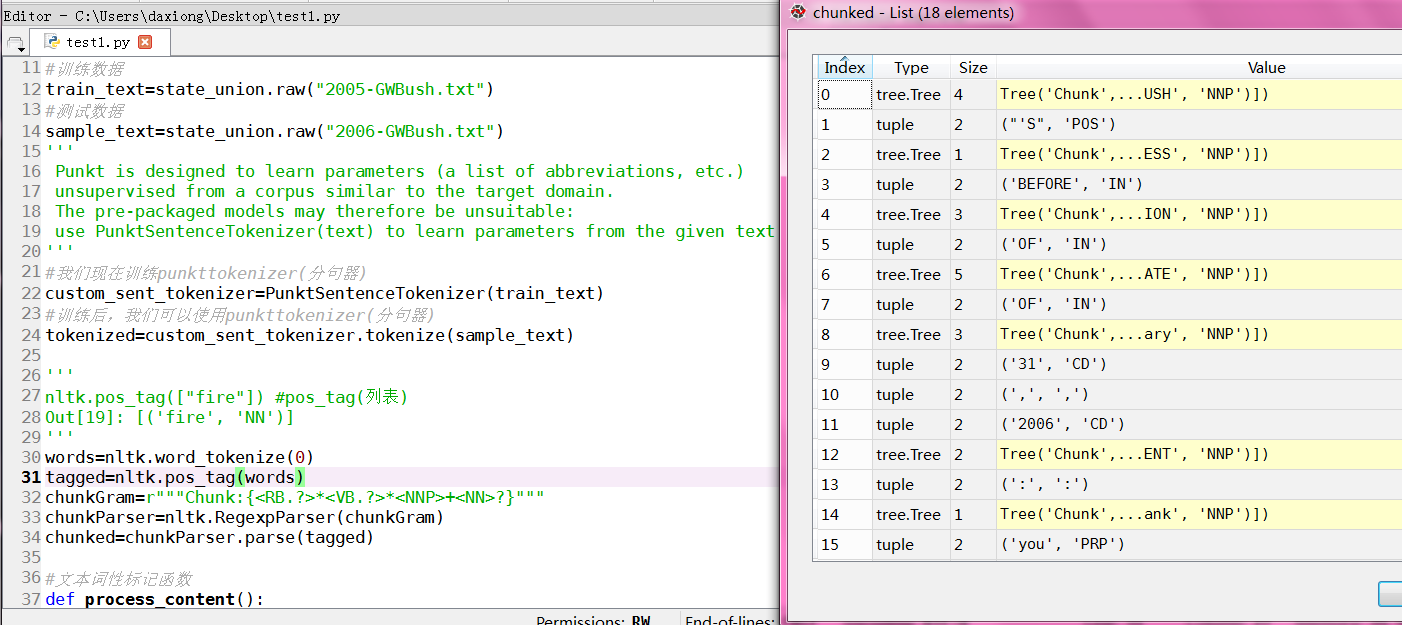
数据类型:chunked 是树结构
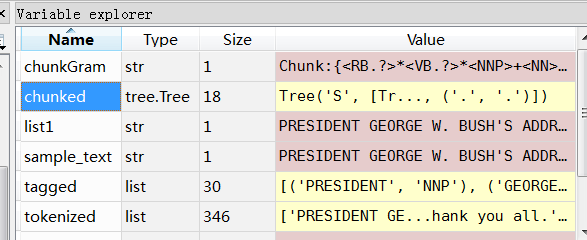
#lambda t:t.label()=='Chunk' 包含Chunk标签的列
输出只包含Chunk标签的列

完整代码
# -*- coding: utf-8 -*-
"""
Created on Sun Nov 13 09:14:13 2016 @author: daxiong
"""
import nltk
from nltk.corpus import state_union
from nltk.tokenize import PunktSentenceTokenizer #训练数据
train_text=state_union.raw("2005-GWBush.txt")
#测试数据
sample_text=state_union.raw("2006-GWBush.txt")
'''
Punkt is designed to learn parameters (a list of abbreviations, etc.)
unsupervised from a corpus similar to the target domain.
The pre-packaged models may therefore be unsuitable:
use PunktSentenceTokenizer(text) to learn parameters from the given text
'''
#我们现在训练punkttokenizer(分句器)
custom_sent_tokenizer=PunktSentenceTokenizer(train_text)
#训练后,我们可以使用punkttokenizer(分句器)
tokenized=custom_sent_tokenizer.tokenize(sample_text) '''
nltk.pos_tag(["fire"]) #pos_tag(列表)
Out[19]: [('fire', 'NN')]
'''
'''
#测试语句
words=nltk.word_tokenize(tokenized[0])
tagged=nltk.pos_tag(words)
chunkGram=r"""Chunk:{<RB.?>*<VB.?>*<NNP>+<NN>?}"""
chunkParser=nltk.RegexpParser(chunkGram)
chunked=chunkParser.parse(tagged)
#lambda t:t.label()=='Chunk' 包含Chunk标签的列
for subtree in chunked.subtrees(filter=lambda t:t.label()=='Chunk'):
print(subtree)
''' #文本词性标记函数
def process_content():
try:
for i in tokenized[0:5]:
words=nltk.word_tokenize(i)
tagged=nltk.pos_tag(words)
#RB副词,VB动词,NNP专有名词单数形式,NN单数名词
chunkGram=r"""Chunk:{<RB.?>*<VB.?>*<NNP>+<NN>?}"""
chunkParser=nltk.RegexpParser(chunkGram)
chunked=chunkParser.parse(tagged)
#print(chunked)
for subtree in chunked.subtrees(filter=lambda t:t.label()=='Chunk'):
print(subtree)
#chunked.draw()
except Exception as e:
print(str(e)) process_content()
得到所有名词分类
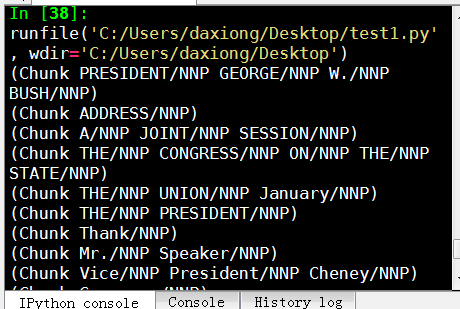
Now that we know the parts of speech, we can do what is called chunking, and group words into hopefully meaningful chunks. One of the main goals of chunking is to group into what are known as "noun phrases." These are phrases of one or more words that contain a noun, maybe some descriptive words, maybe a verb, and maybe something like an adverb. The idea is to group nouns with the words that are in relation to them.
In order to chunk, we combine the part of speech tags with regular expressions. Mainly from regular expressions, we are going to utilize the following:
+ = match 1 or more
? = match 0 or 1 repetitions.
* = match 0 or MORE repetitions
. = Any character except a new line
See the tutorial linked above if you need help with regular expressions. The last things to note is that the part of speech tags are denoted with the "<" and ">" and we can also place regular expressions within the tags themselves, so account for things like "all nouns" (<N.*>)
import nltk
from nltk.corpus import state_union
from nltk.tokenize import PunktSentenceTokenizer train_text = state_union.raw("2005-GWBush.txt")
sample_text = state_union.raw("2006-GWBush.txt") custom_sent_tokenizer = PunktSentenceTokenizer(train_text) tokenized = custom_sent_tokenizer.tokenize(sample_text) def process_content():
try:
for i in tokenized:
words = nltk.word_tokenize(i)
tagged = nltk.pos_tag(words)
chunkGram = r"""Chunk: {<RB.?>*<VB.?>*<NNP>+<NN>?}"""
chunkParser = nltk.RegexpParser(chunkGram)
chunked = chunkParser.parse(tagged)
chunked.draw() except Exception as e:
print(str(e)) process_content()
The result of this is something like:
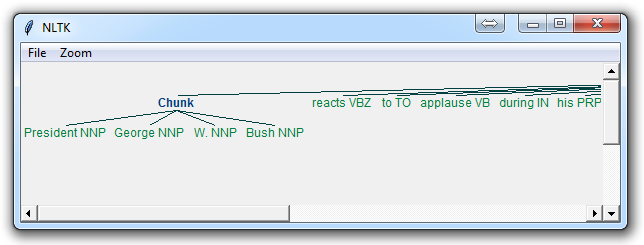
The main line here in question is:
chunkGram = r"""Chunk: {<RB.?>*<VB.?>*<NNP>+<NN>?}"""
This line, broken down:
<RB.?>* = "0 or more of any tense of adverb," followed by:
<VB.?>* = "0 or more of any tense of verb," followed by:
<NNP>+ = "One or more proper nouns," followed by
<NN>? = "zero or one singular noun."
Try playing around with combinations to group various instances until you feel comfortable with chunking.
Not covered in the video, but also a reasonable task is to actually access the chunks specifically. This is something rarely talked about, but can be an essential step depending on what you're doing. Say you print the chunks out, you are going to see output like:
(S
(Chunk PRESIDENT/NNP GEORGE/NNP W./NNP BUSH/NNP)
'S/POS
(Chunk
ADDRESS/NNP
BEFORE/NNP
A/NNP
JOINT/NNP
SESSION/NNP
OF/NNP
THE/NNP
CONGRESS/NNP
ON/NNP
THE/NNP
STATE/NNP
OF/NNP
THE/NNP
UNION/NNP
January/NNP)
31/CD
,/,
2006/CD
THE/DT
(Chunk PRESIDENT/NNP)
:/:
(Chunk Thank/NNP)
you/PRP
all/DT
./.)
Cool, that helps us visually, but what if we want to access this data via our program? Well, what is happening here is our "chunked" variable is an NLTK tree. Each "chunk" and "non chunk" is a "subtree" of the tree. We can reference these by doing something like chunked.subtrees. We can then iterate through these subtrees like so:
for subtree in chunked.subtrees():
print(subtree)
Next, we might be only interested in getting just the chunks, ignoring the rest. We can use the filter parameter in the chunked.subtrees() call.
for subtree in chunked.subtrees(filter=lambda t: t.label() == 'Chunk'):
print(subtree)
Now, we're filtering to only show the subtrees with the label of "Chunk." Keep in mind, this isn't "Chunk" as in the NLTK chunk attribute... this is "Chunk" literally because that's the label we gave it here: chunkGram = r"""Chunk: {<RB.?>*<VB.?>*<NNP>+<NN>?}"""
Had we said instead something like chunkGram = r"""Pythons: {<RB.?>*<VB.?>*<NNP>+<NN>?}""", then we would filter by the label of "Pythons." The result here should be something like:
-
(Chunk PRESIDENT/NNP GEORGE/NNP W./NNP BUSH/NNP)
(Chunk
ADDRESS/NNP
BEFORE/NNP
A/NNP
JOINT/NNP
SESSION/NNP
OF/NNP
THE/NNP
CONGRESS/NNP
ON/NNP
THE/NNP
STATE/NNP
OF/NNP
THE/NNP
UNION/NNP
January/NNP)
(Chunk PRESIDENT/NNP)
(Chunk Thank/NNP)
Full code for this would be:
import nltk
from nltk.corpus import state_union
from nltk.tokenize import PunktSentenceTokenizer train_text = state_union.raw("2005-GWBush.txt")
sample_text = state_union.raw("2006-GWBush.txt") custom_sent_tokenizer = PunktSentenceTokenizer(train_text) tokenized = custom_sent_tokenizer.tokenize(sample_text) def process_content():
try:
for i in tokenized:
words = nltk.word_tokenize(i)
tagged = nltk.pos_tag(words)
chunkGram = r"""Chunk: {<RB.?>*<VB.?>*<NNP>+<NN>?}"""
chunkParser = nltk.RegexpParser(chunkGram)
chunked = chunkParser.parse(tagged) print(chunked)
for subtree in chunked.subtrees(filter=lambda t: t.label() == 'Chunk'):
print(subtree) chunked.draw() except Exception as e:
print(str(e)) process_content()
If you get particular enough, you may find that you may be better off if there was a way to chunk everything, except some stuff. This process is what is known as chinking, and that's what we're going to be covering next.
自然语言16_Chunking with NLTK的更多相关文章
- 转 --自然语言工具包(NLTK)小结
原作者:http://www.cnblogs.com/I-Tegulia/category/706685.html 1.自然语言工具包(NLTK) NLTK 创建于2001 年,最初是宾州大学计算机与 ...
- 自然语言22_Wordnet with NLTK
QQ:231469242 欢迎喜欢nltk朋友交流 https://www.pythonprogramming.net/wordnet-nltk-tutorial/?completed=/nltk-c ...
- 自然语言17_Chinking with NLTK
https://www.pythonprogramming.net/chinking-nltk-tutorial/?completed=/chunking-nltk-tutorial/ 代码 # -* ...
- Python自然语言处理工具NLTK的安装FAQ
1 下载Python 首先去python的主页下载一个python版本http://www.python.org/,一路next下去,安装完毕即可 2 下载nltk包 下载地址:http://www. ...
- Python自然语言工具包(NLTK)入门
在本期文章中,小生向您介绍了自然语言工具包(Natural Language Toolkit),它是一个将学术语言技术应用于文本数据集的 Python 库.称为“文本处理”的程序设计是其基本功能:更深 ...
- Python NLTK 自然语言处理入门与例程(转)
转 https://blog.csdn.net/hzp666/article/details/79373720 Python NLTK 自然语言处理入门与例程 在这篇文章中,我们将基于 Pyt ...
- NLTK在自然语言处理
nltk-data.zip 本文主要是总结最近学习的论文.书籍相关知识,主要是Natural Language Pracessing(自然语言处理,简称NLP)和Python挖掘维基百科Infobox ...
- Python自然语言处理工具小结
Python自然语言处理工具小结 作者:白宁超 2016年11月21日21:45:26 目录 [Python NLP]干货!详述Python NLTK下如何使用stanford NLP工具包(1) [ ...
- 自然语言处理(NLP)入门学习资源清单
Melanie Tosik目前就职于旅游搜索公司WayBlazer,她的工作内容是通过自然语言请求来生产个性化旅游推荐路线.回顾她的学习历程,她为期望入门自然语言处理的初学者列出了一份学习资源清单. ...
随机推荐
- php学习手记
在学习常量的时候,一直觉得奇怪 为啥常量的时候总是有个“.”在常量的后面,经过学习现在得知该点是 相当于Java当中的“+”用于连接字符 <?php header("Content-t ...
- javascript: return return false
一:代码(王工)var flag=true; $(function(){ $("#ff").submit(function(){ // 表单submit事件 registerUse ...
- SimpleDateFormate的使用
import java.text.ParseException; import java.text.SimpleDateFormat; import java.util.Date; public cl ...
- iOS开发小技巧-修改SliderBar指针的样式(牢记这个方法,只能通过代码来修改)
代码: // 修改进度条的指针图片 [self.progressSlider setThumbImage:[UIImage imageNamed:@"player_slider_playba ...
- python 中的sort 和java中的Collections.sort()函数的使用
x=[1,2,3] x.sort()对的,x这个都变了 y=x.sort()错误 y=sorted(x)对的,x拍好序的一个副本 python中用匿名函数和自定义函数排序:(很奇怪的是比较函数返回的是 ...
- 第一个PyQt程序
这个程序虽然小,具备pyqt程序的皱型,可以作为一个模板使用了 #!/usr/bin/python3 # -*- coding: utf-8 -*- import sys from PyQt5.QtW ...
- Js-动态控制table的tr、td增加及删除的具体实现
<table id='wifi_clients_table' style="color:#0099CC;font-size:12px;" class="table ...
- 操作系统也谈"算法"
前言: 近来在准备校招的笔试面试,复习到操作系统时感觉概念性的东西比较多,不过对于以下的几类算法还是有必要做个小小总结. [作业调度算法] 先来先服务(FCFS, First Come First S ...
- HDFS文件和HIVE表的一些操作
1. hadoop fs -ls 可以查看HDFS文件 后面不加目录参数的话,默认当前用户的目录./user/当前用户 $ hadoop fs -ls 16/05/19 10:40:10 WARN ...
- css-transition和transform实现图片悬浮移动动画
今天在京东首页上看到一个效果,鼠标悬浮在图片上时,图片发生移动,鼠标移走时再移回,并且有一个过渡效果. 貌似很简单,自己做做试试吧 我首先使用的是jquery在鼠标悬浮到图片上给图片增加一个类,这个类 ...

